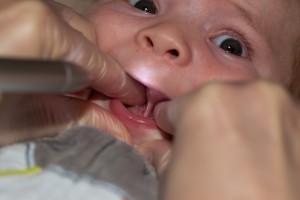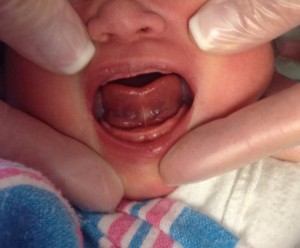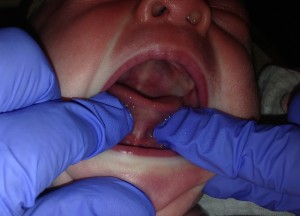Research Review: Are There Any Benefits to Performing an Early Frenotomy on Newborns?
By: Sharon Muza, BS, LCCE, FACCE, CD/BDT(DONA), CLE | 0 Comments
By Elias Kass, ND, LM, CPM
Breastfeeding is often considered the next big challenge after childbirth. New mothers and babies work together to establish a successful breastfeeding relationship. Sometimes, there are complications that can make things harder than they should be. Tongue tie is one of the circumstances that can interfere with getting the breastfeeding relationship off to a good start. Please welcome Dr. Elias Kass, to Science & Sensibility as he reviews a recent study on early frenotomy (tongue tie clipping) in newborns and shares his thoughts on the study results. - Sharon Muza, Community Manager
With tongue tie seemingly on the rise, it's always nice to see new literature approach the issue. 'Randomised controlled trial of early frenotomy in breastfed infants with mild-moderate tongue-tie' (Emond et al) compares releasing the tongue tie (frenotomy) immediately versus waiting and providing standard breastfeeding support.
What is tongue tie?
Tongue tie describes the presence of a frenulum that restricts the tongue's ability to reach out and grasp the breast for successful breastfeeding.

Anterior tongue tie
Image Source: Melissa Cole, IBCLC, RLC/p>
The most profound anterior tongue tie is one that connects the tip of the tongue to the edge of the gum. These babies have a V- or heart-shaped tongue when they cry, cannot extend their tongue at all, cannot follow a finger tracing along their bottom gum, and cannot generally latch well. Tongue ties can occur all along the spectrum of the tongue and the floor of the mouth, and some are hidden under the surface layer of skin, which we call 'posterior tongue tie.'
The role of the tongue in breastfeeding
The tongue is incredibly important in breastfeeding. The baby must reach out with his tongue and grasp the breast. The tongue forms the primary seal, preventing milk loss and air intake. The movement is intrinsic to the tongue. Rather than sawing the tongue in and out, the muscular impulse starts at the tip of the tongue and moves inward, moving milk from the breast into the mouth. The middle of the tongue acts to form the milk into a ball, and the back of the tongue is responsible for coordinating swallowing, raising the larynx so that milk is directed down the esophagus and not down the trachea into the lungs.
What happens when a baby is tongue tied?
Tongue tie interferes with this intricate coordination in many ways. Some babies cannot extend their tongue. Those babies will have difficulty finding and attaching to the breast, but they may be able to nurse if the nipple is placed in their mouth just right. These babies come off the breast easily and become frustrated because they cannot adjust the position of the nipple in the mouth. The babies who are so tied they cannot extend their tongue over their bottom gum will reflexively clamp their gums. To the nursing parent, this pressure can feel like biting, and can damage nipples incredibly quickly, causing cracking, bleeding, pain, and because the skin is now broken, infection. 
Some babies can extend their tongue against the 'rubber band' of the tongue tie, but their tongues 'snap back' frequently. This can feel like a sawing against the underside of the nipple, and that friction can also damage nipples. These babies tire easily, because their feeding is made more difficult by the resistance of the rubber band. Snap back can sound like clicking. Clicking can also be caused by loss of suction from the underside of the breast. The tongue should stay mostly in the middle of the mouth when breastfeeding, with the jaw opening to create suction in the middle and back of the mouth. If, when baby opens her jaw, the tongue is tied to the bottom of the mouth, her tongue will snap away from the breast, losing suction.
Some babies can extend but not cup their tongues. These babies generally mash the nipple against the roof of the mouth, causing flattened, ridged nipples. Others thrust their tongue against the nipple instead of reaching under it, which leaves the nipple looking like a lipstick applicator.
What is a frenotomy?
Frenotomy refers to the procedure where this tongue tie is released (or in some places, 'revised'). Though not all providers perform this procedure, providers from many different specialties have been known to offer it: pediatricians, family practice doctors, ear nose and throat specialists, dentists, and some midwives. For most, it is a simple, in-office procedure.
What did this study look at?
The researchers determined which babies were tongue tied based on the Hazelbaker Assessment Tool for Lingual Frenulum Function and the LATCH score (Latch, Audible swallowing, nipple Type, Comfort, Hold ). Those who had mild-moderate tongue tie according to the Hazelbaker score, as well as a LATCH score less than 8 out of 10 were eligible for the study. Those babies with severe tongue tie according to the Hazelbaker score were not randomized, and were instead offered immediate frenotomy; their outcomes were not considered as part of the study. Some parents of babies who otherwise qualified for the study refused to be randomized because they felt strongly about receiving frenotomy upon diagnosis.
When considering whether to intervene for tongue tie, it's important to consider appearance as well as functionality. Some tongue ties are not readily visible but interfere greatly with functionality. Some tongue ties appear dramatic, but breastfeeding is not affected. (There are other long-term considerations, like speech and oral health, in deciding whether or not to release a tongue tie that is not affecting breastfeeding.) The Hazelbaker score is a good way to evaluate functionality because it takes into account whether baby can extend her tongue, cup it into the appropriate shape, moved it appropriately, and maintain suction, as well as the severity in appearance. The Hazelbaker score has good inter-scorer correlation, meaning that different professionals using the tool will arrive at the same conclusion (whether or not the baby should have a frenotomy) nearly 90% of the time. Using a consistent tool can help the individual provider get a better sense of who needs the procedure, but it can also help us as readers to know whether the study population was appropriate, and whether the study's conclusions can inform our own practice.

V-shaped tongue
Image Source: Osama Moshet, MD, FAAP
The LATCH score is a very broad evaluation of how breastfeeding is going, and despite its name, only barely addresses latch itself. Using such a general assessment in conjunction with the Hazelbaker score may have helped the researchers isolate the babies who were both tongue tied and having difficulties breastfeeding, as opposed to those who were tongue tied but doing okay.
In measuring outcomes, they used these two measures again, and added several more measures concerning breastfeeding behavior of newborns, breastfeeding self-efficacy (how confident mom felt in her ability to feed her baby, as well as an observer's evaluation of breastfeeding effectiveness), and pain.
Conclusion
The primary outcome was LATCH score at 5 days. Secondary outcomes were LATCH score at 8 weeks, and the other measures listed above at 5 days and 8 weeks. The Hazelbaker score was another 'outcome of interest' at 5 days, as was infant weight at 8 weeks. At 5 days, parents could choose to have frenotomy regardless of whether they had been randomized to the control arm or the intervention arm.
The researchers concluded 'Early frenotomy did not result in an objective improvement in breastfeeding but was associated with improved self-efficacy. The majority in the comparison arm opted for the intervention after 5-days.'
Discussion
Though the study is structured fairly soundly, it doesn't really answer its own question of whether frenotomy helps improve breastfeeding, largely because of the outcomes they chose to study. The LATCH score is not an indication of tongue functionality, success of frenotomy, or long-term breastfeeding success. Five days is also probably too soon to pass final judgement on whether the frenotomy helped; babies and nipples are still healing. The study also excluded those with severe tongue tie, and it's safe to assume these babies would have significant improvement when their tongue ties were corrected.
Mothers did feel significantly more effective in their feeding when their babies had received frenotomy (which is correlated with duration of breastfeeding), and more of those who didn't receive frenotomy were feeding by bottle. It's unclear whether this bottle feeding was because of the pain associated with breastfeeding or because of inadequate milk transfer or nutrition, but it's possible that some of those parents have been helped by immediate frenotomy. Indeed, some of the mothers who had been randomized to the control group requested early frenotomy because their feeding was so painful. There were statistically significant improvements in the Hazelbaker score, representing improvement in both appearance and functionality.

Very thick submucosal/posterior tongue tie.
Image Source: Bay Area Breastfeeding & Education,
LLC www.bayareabreastfeeding.net
Many features of this study mirror how I treat tongue tie in my practice. Almost all babies are referred by lactation consultants or their own pediatricians because they are having difficulty breastfeeding, or because their tongue ties are so profound that we can anticipate speech and oral health problems if it's not corrected. I use both the Hazelbaker score and the scoring tool in the appendix of RL Martinelli's 'Lingual frenulum protocol with scores for infants' to capture the infant's feeding history, anatomy, and functionality on both the gloved finger and at the breast. These scores help support a systematic approach to these infants, and helps communicate back to their referring provider what I'm looking for when I decide whether or not to recommend frenotomy. Though most babies referred do need frenotomy, some need other kinds of support instead, and some just need reassurance around normal feeding patterns.
The article didn't go into much detail about the aftercare. Aftercare is a crucial variable in improving breastfeeding and maximizing success of the procedure. Seattle area practices who perform significant numbers of frenotomy have collaborated to create a list of exercises we ask parents to do with their babies 5 times daily for a week to keep the area open, reduce reattachment, and help baby learn to maximize their new freedom of movement. We also generally recommend craniosacral therapy to help release tight muscles and retrain movement patterns. Many families have incorporated other feeding tools or accessories into their regimens, whether that's nipple shields, bottles, supplemental nursing systems, or formula. With frenotomy, most will be able to start to move away from those tools, and need continued support from a lactation consultant to relearn how to nurse at the breast. Though most mothers feel that baby nurses differently immediately, some babies take longer to change their approach, and some do not benefit at all.
Releasing tongue ties is a very satisfying part of my practice. I love when breastfeeding parents nurse immediately after the procedure and their faces light up because for the first time it doesn't hurt to feed. These parents have been working very, very hard to breastfeed, and I feel strongly that this procedure removes a significant obstacle. The more I work with breastfeeding families, the more in awe I am of the complexity of breastfeeding, and importance of excellent breastfeeding support.
Childbirth and breastfeeding educators should be sharing that painful breastfeeding sessions are not normal and should be evaluated by a lactation consultant. Educators should provide resources for qualified LCs in their communities to families in need. For those that work with breastfeeding dyads, what are you seeing in terms of tongue tie and treatment success? Please share your experiences.- SM
References
Ballard, J. L., Auer, C. E., & Khoury, J. C. (2002). Ankyloglossia: assessment, incidence, and effect of frenuloplasty on the breastfeeding dyad.Pediatrics, 110(5), e63-e63.
Emond, A., Ingram, J., Johnson, D., Blair, P., Whitelaw, A., Copeland, M., & Sutcliffe, A. (2013). Randomised controlled trial of early frenotomy in breastfed infants with mild-moderate tongue-tie. Archives of Disease in Childhood-Fetal and Neonatal Edition, fetalneonatal-2013.
Martinelli RL de C, Marchesan IQ, Berretin-Felix G. Lingual frenulum protocol with scores for infants. Int J Orofacial Myology. 2012;38:104-112.
About Dr. Elias Kass
Elias Kass, ND, LM, CPM, is a naturopathic physician and licensed midwife practicing as part of One Sky Family Medicine in Seattle, Washington. He provides integrative family primary care for children and their parents, including prenatal, birth and pediatric care. He loves working with babies! Practice information and Dr Kass's contact info is available at One Sky Family Medicine.
Published: December 09, 2013
Tags
BreastfeedingTongue tieNew ResearchNewbornsMaternal Infant CareBabiesElias KassFenotomy